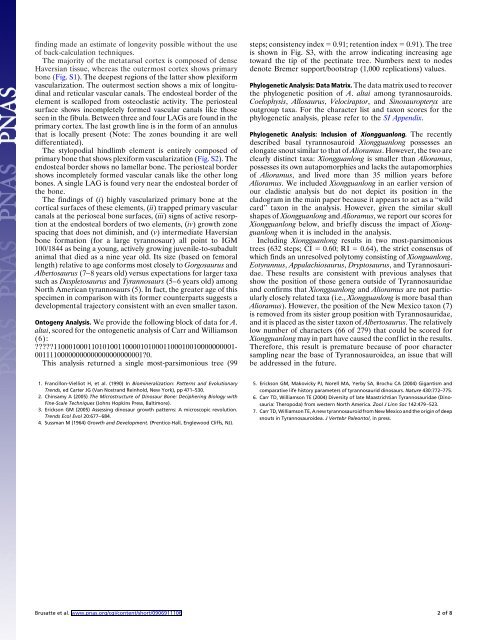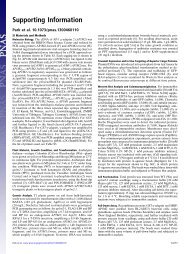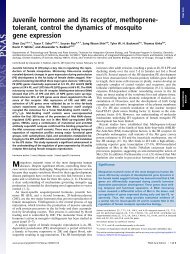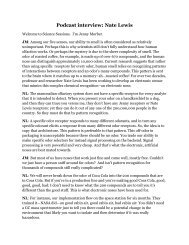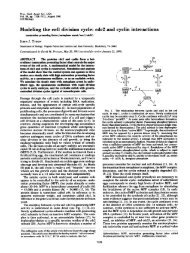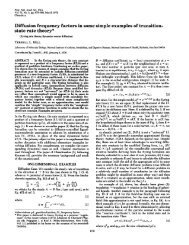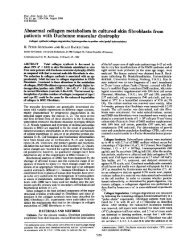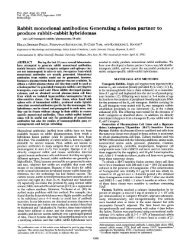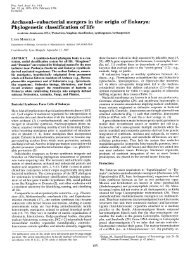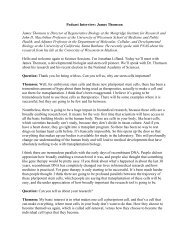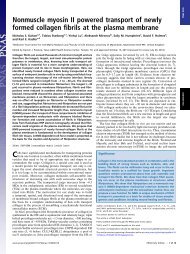Download Supporting Information (PDF)
Download Supporting Information (PDF)
Download Supporting Information (PDF)
Create successful ePaper yourself
Turn your PDF publications into a flip-book with our unique Google optimized e-Paper software.
finding made an estimate of longevity possible without the use<br />
of back-calculation techniques.<br />
The majority of the metatarsal cortex is composed of dense<br />
Haversian tissue, whereas the outermost cortex shows primary<br />
bone (Fig. S1). The deepest regions of the latter show plexiform<br />
vascularization. The outermost section shows a mix of longitudinal<br />
and reticular vascular canals. The endosteal border of the<br />
element is scalloped from osteoclastic activity. The periosteal<br />
surface shows incompletely formed vascular canals like those<br />
seen in the fibula. Between three and four LAGs are found in the<br />
primary cortex. The last growth line is in the form of an annulus<br />
that is locally present (Note: The zones bounding it are well<br />
differentiated).<br />
The stylopodial hindlimb element is entirely composed of<br />
primary bone that shows plexiform vascularization (Fig. S2). The<br />
endosteal border shows no lamellar bone. The periosteal border<br />
shows incompletely formed vascular canals like the other long<br />
bones. A single LAG is found very near the endosteal border of<br />
the bone.<br />
The findings of (i) highly vascularized primary bone at the<br />
cortical surfaces of these elements, (ii) trapped primary vascular<br />
canals at the perioseal bone surfaces, (iii) signs of active resorption<br />
at the endosteal borders of two elements, (iv) growth zone<br />
spacing that does not diminish, and (v) intermediate Haversian<br />
bone formation (for a large tyrannosaur) all point to IGM<br />
100/1844 as being a young, actively growing juvenile-to-subadult<br />
animal that died as a nine year old. Its size (based on femoral<br />
length) relative to age conforms most closely to Gorgosaurus and<br />
Albertosaurus (7–8 years old) versus expectations for larger taxa<br />
such as Daspletosaurus and Tyrannosaurs (5–6 years old) among<br />
North American tyrannosaurs (5). In fact, the greater age of this<br />
specimen in comparison with its former counterparts suggests a<br />
developmental trajectory consistent with an even smaller taxon.<br />
Ontogeny Analysis. We provide the following block of data for A.<br />
altai, scored for the ontogenetic analysis of Carr and Williamson<br />
(6):<br />
?????110001000110101001100001010001100010010000000001-<br />
00111100000000000000000000001?0.<br />
This analysis returned a single most-parsimonious tree (99<br />
1. Francillon-Vielliot H, et al. (1990) In Biomineralization: Patterns and Evolutionary<br />
Trends, ed Carter JG (Van Nostrand Reinhold, New York), pp 471–530.<br />
2. Chinsamy A (2005) The Microstructure of Dinosaur Bone: Deciphering Biology with<br />
Fine-Scale Techniques (Johns Hopkins Press, Baltimore).<br />
3. Erickson GM (2005) Assessing dinosaur growth patterns: A microscopic revolution.<br />
Trends Ecol Evol 20:677–684.<br />
4. Sussman M (1964) Growth and Development. (Prentice-Hall, Englewood Cliffs, NJ).<br />
steps; consistency index 0.91; retention index 0.91). The tree<br />
is shown in Fig. S3, with the arrow indicating increasing age<br />
toward the tip of the pectinate tree. Numbers next to nodes<br />
denote Bremer support/bootstrap (1,000 replications) values.<br />
Phylogenetic Analysis: Data Matrix. The data matrix used to recover<br />
the phylogenetic position of A. altai among tyrannosauroids.<br />
Coelophysis, Allosaurus, Velociraptor, and Sinosauropteryx are<br />
outgroup taxa. For the character list and taxon scores for the<br />
phylogenetic analysis, please refer to the SI Appendix.<br />
Phylogenetic Analysis: Inclusion of Xiongguanlong. The recently<br />
described basal tyrannosauroid Xiongguanlong possesses an<br />
elongate snout similar to that of Alioramus. However, the two are<br />
clearly distinct taxa: Xiongguanlong is smaller than Alioramus,<br />
possesses its own autapomorphies and lacks the autapomorphies<br />
of Alioramus, and lived more than 35 million years before<br />
Alioramus. We included Xiongguanlong in an earlier version of<br />
our cladistic analysis but do not depict its position in the<br />
cladogram in the main paper because it appears to act as a ‘‘wild<br />
card’’ taxon in the analysis. However, given the similar skull<br />
shapes of Xiongguanlong and Alioramus, we report our scores for<br />
Xiongguanlong below, and briefly discuss the impact of Xiongguanlong<br />
when it is included in the analysis.<br />
Including Xiongguanlong results in two most-parsimonious<br />
trees (632 steps; CI 0.60; RI 0.64), the strict consensus of<br />
which finds an unresolved polytomy consisting of Xionguanlong,<br />
Eotyrannus, Appalachiosaurus, Dryptosaurus, and Tyrannosauridae.<br />
These results are consistent with previous analyses that<br />
show the position of those genera outside of Tyrannosauridae<br />
and confirms that Xiongguanlong and Alioramus are not particularly<br />
closely related taxa (i.e., Xiongguanlong is more basal than<br />
Alioramus). However, the position of the New Mexico taxon (7)<br />
is removed from its sister group position with Tyrannosauridae,<br />
and it is placed as the sister taxon of Albertosaurus. The relatively<br />
low number of characters (66 of 279) that could be scored for<br />
Xiongguanlong may in part have caused the conflict in the results.<br />
Therefore, this result is premature because of poor character<br />
sampling near the base of Tyrannosauroidea, an issue that will<br />
be addressed in the future.<br />
5. Erickson GM, Makovicky PJ, Norell MA, Yerby SA, Brochu CA (2004) Gigantism and<br />
comparative life history parameters of tyrannosaurid dinosaurs. Nature 430:772–775.<br />
6. Carr TD, Williamson TE (2004) Diversity of late Maastrichtian Tyrannosauridae (Dinosauria:<br />
Theropoda) from western North America. Zool J Linn Soc 142:479–523.<br />
7. Carr TD, Williamson TE, A new tyrannosauroid from New Mexico and the origin of deep<br />
snouts in Tyrannosauroidea. J Vertebr Paleontol, in press.<br />
Brusatte et al. www.pnas.org/cgi/content/short/0906911106 2of8


